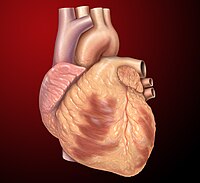
Photo from wikipedia
OBJECTIVES Imaging studies have shown brain abnormalities associated with eating behavior (taste perception, food intake, and food reward), neural connectivity, and cognition related to obesity. The aim of this study… Click to show full abstract
OBJECTIVES Imaging studies have shown brain abnormalities associated with eating behavior (taste perception, food intake, and food reward), neural connectivity, and cognition related to obesity. The aim of this study was to investigate whether obese individuals have changes in regional cerebral blood flow (rCBF) during fasting and rest using single-photon emission computed tomography (SPECT), and whether these differences are associated with body fat and serum levels of leptin, insulin, and glucose. METHODS For this purpose, rCBF assessed by ([99]mTc)-ECD-SPECT was compared between 10 obese women (30 ± 5 y of age, body fat: 38 ± 3 kg) and 10 lean women (30 ± 6 y of age, body fat: 17 ± 5 kg) using statistical parametric mapping. Pearson's coefficient and linear regression were used to search for associations among variables. RESULTS The obese women showed antagonic rCBF in the left frontoparietal region and greater rCBF in areas related to the default mode network and the salience network (P = 0.0001). Positive linear correlations of rCBF, body fat, and the serum levels of glucose and insulin were found, but no associations were detected using linear regression. CONCLUSION Obese women showed rCBF differences in areas related to the frontoparietal neural circuit, the default mode network, and the salience network, suggesting loss of cognitive control and a higher perception of physiologic processes, such as hunger. Hyperactivation in these areas might jeopardize the recognition of changes in energy homeostasis.
Journal Title: Nutrition
Year Published: 2020
Link to full text (if available)
Share on Social Media: Sign Up to like & get
recommendations!